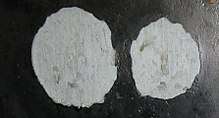High-explosive squash head
High-explosive squash head (HESH) is a type of explosive ammunition that is somewhat effective against tank armor and is also useful against buildings and infantry. It was fielded chiefly by the British Army as the main explosive round of its main battle tanks during the Cold War. It was also used by other military forces, particularly those that acquired the early post-World War II British 105 mm Royal Ordnance L7A1, including Germany, India, Israel and Sweden. In the United States, it is known as HEP, for "high explosive, plastic".

Description
HESH rounds are thin metal shells filled with plastic explosive and a delayed-action base fuze. The plastic explosive is "squashed" against the surface of the target on impact and spreads out to form a disc or "pat" of explosive. The base fuze detonates the explosive milliseconds later, creating a shock wave that, owing to its large surface area and direct contact with the target, is transmitted through the material. In the case of the metal armour of a tank, the compression shock wave is conducted through the armour to the point where it reaches the metal/air interface (the hollow crew compartment), where some of the energy is reflected as a tension wave. At the point where the compression and tension waves intersect, a high-stress zone is created in the metal, causing pieces of steel to be projected off the interior wall at high velocity. This fragmentation by blast wave is known as spalling, with the fragments themselves known as spall. The spall travels through the interior of the vehicle at high velocity, killing or injuring the crew, damaging equipment, and/or igniting ammunition and fuel. Unlike high-explosive anti-tank (HEAT) rounds, which are shaped charge ammunition, HESH shells are not specifically designed to perforate the armour of main battle tanks. HESH shells rely instead on the transmission of the shock wave through the solid steel armour.
HESH ammunition has good general purpose use, being effective against most targets, though the round is generally used at relatively low velocities because high velocity excessively disperses the pat of explosive. While only effective against tanks without spaced armour or spall liners, the round is still highly favoured for combat demolition purposes. The flattened high-velocity explosive pat is capable of destroying concrete constructions much faster than a HEAT round (which is designed for armour penetration), and without the dangerous fragmentation of a traditional high-explosive (HE) fragmentation round.
History
_56.1_build_a_1%2C500-pound_munitions_dispo.jpg)
HESH was developed by Dennistoun Burney in the 1940s for the UK's war effort, originally as an anti-fortification "wallbuster" munition for use against concrete. He also led British developments in recoilless rifles as a means to deliver the shell. An early application of the HESH principle was the Royal Engineers AVRE's 165mm demolition gun.
HESH was found to be surprisingly effective against metallic armour as well, although the UK already had effective weapons using HEAT, such as the PIAT. HESH was for some time a competitor to the more common HEAT round, again in combination with recoilless rifles as infantry weapons, and was effective against tanks such as the earlier models of the T-55 and T-62; later models had a layer of spall liner, which decreased the effectiveness of the HESH round. In the 1960s, the UK also devised anti-tank guided missiles with HESH warheads, such as the Malkara, although most subsequent designs used variants of the HEAT concept.
Since the 1970s, HESH ammunition has increasingly fallen out of favour as armour designs have trended towards layered composites of hard metal and heat-resistant materials. This type of armour is a poor conductor of shock waves. Anti-spalling devices (spall liners), made of materials such as Kevlar, are commonly fitted to the interior surface of modern armoured vehicles to minimise spalling effects. Another reason for the declining use of HESH rounds is the preference of most armies for smoothbore cannons. Rifling decreases the penetrating power of HEAT warheads because the centrifugal force of the spinning projectile tends to disperse the shaped charge jet, but this same effect can assist a HESH shell by increasing the surface area of contact. The British Army has persisted with a rifled cannon on their Challenger 1 and Challenger 2 battle tanks partly to preserve the general purpose capability of HESH ammunition. Nevertheless, the British Army had planned for a conversion to the more versatile smoothbore cannons, but the project was cancelled due to budget constraints. This would have allowed them to take advantage of commonality with NATO partners and the greater availability of smoothbore ammunition types, such as high-explosive (HE), time-fuzed and canister shot. British rifled tanks have been limited to two offensive ammunition types: CHARM, a kinetic energy penetrator, and HESH, but not HEAT.[1]
HESH rounds are currently still carried by armoured engineer vehicles; they are typically intended for use against fortifications rather than armoured fighting vehicles. A 165mm HESH round is used by the United States Army for the main gun of the M728 Combat Engineer Vehicle, an M60 tank equipped with a bulldozer blade. Similarly, the UK's Centurion AVRE (Armoured Vehicle Royal Engineers) was equipped with a short 165mm gun solely for a 29 kg HESH shell.
Amongst other ammunition types, the Stryker Mobile Gun System variant is to be equipped with a 105mm HESH round for demolition and bunker-busting purposes. Argentina's TAM medium tanks, Canada's Leopard C1 and Leopard C2 main battle tanks (all of which mount the same 105 mm gun as the Centurion), the Australian Leopard AS1 main battle tank, the Chinese VT-4 Main Battle Tank (which mounts a 125mm smoothbore gun) and India's Arjun tank (which has the same rifled 120 mm gun as the UK's MBTs) can also fire HESH rounds.
See also
- Misznay–Schardin effect
- Munroe effect
- Rifleman's Assault Weapon
References
- Sean Rayment (21 September 2003). "Army's new tank gun will end use of controversial uranium-tipped shells". Telegraph.